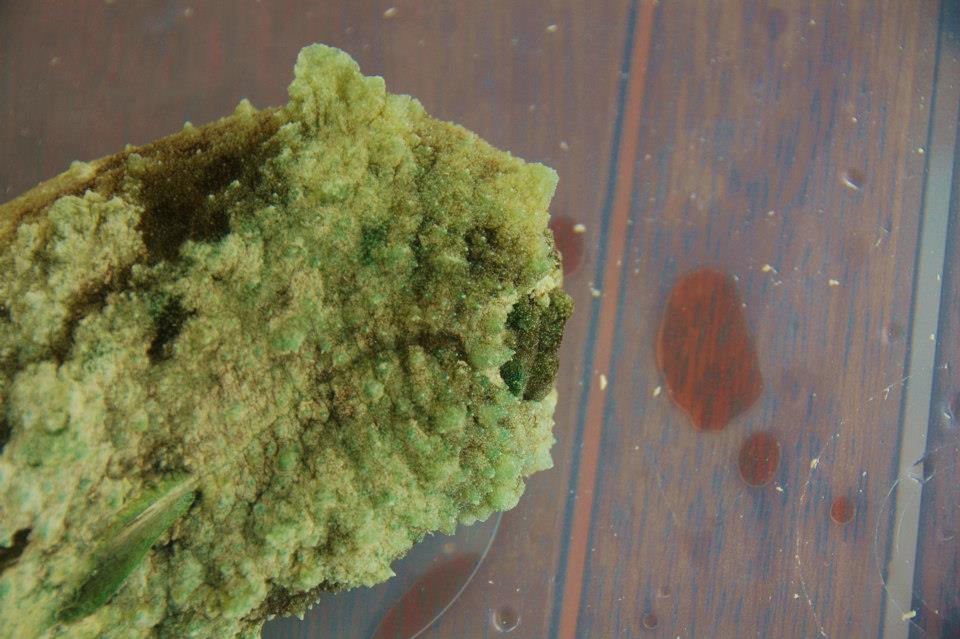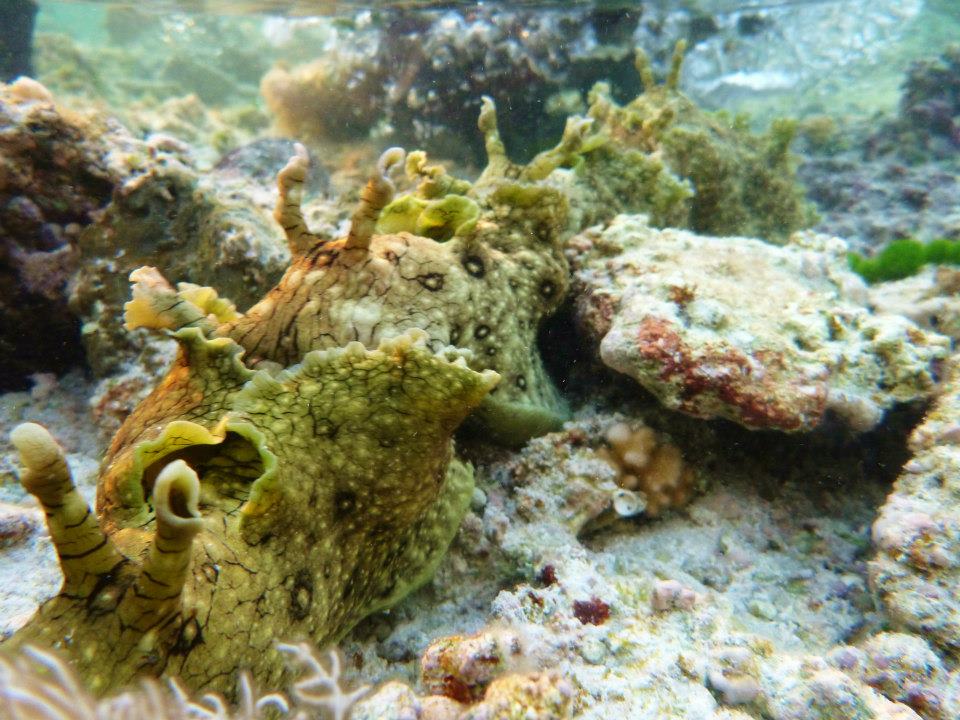Life History & Behaviour
Feeding
| Wedge sea hares are generalist herbivores of algae (Pennings and Paul 1992). Their mixed diet allows for an better growth rate than eating a single species of algae (Pennings et al. 1993). In the aquarium on Heron Island, the sea hares ate the red algae Hypneaspinella sp. (left) and the brown algae Pedina sp. (right), two species commonly found on Heron Island.
|

|
When given algae in the aquarium on Heron Island, the wedge sea hare
grasps the algae with its muscular foot. The body will then curl up into a
ball around the piece of algae and bring its oral lobes to the algae (see right).
|
 |
| The buccal mass will bring the algae to the radula which will scraped
away algae to be ingested (Kandel 1979). If your algae have holes along the edges, then your
sea hare was hungry. |
 |
In Cebu, Phillippines, there was no difference between ingestion rates of algae with the time of day but smaller wedge sea hares ate less algae than larger ones (Lozada et al. 2005). Wedge sea hares are not affected by the chemical defences of algae but have a preference towards less tough algae (Pennings and Paul 1992). The indifference to chemical defences may allow wedge sea hares to utilise the chemical defences of algae for their own defence.
Defences
Sea hares have a variety of defences they employ against their predators throughout their life. Seastars, fish and anemones are all known predators of sea hares (Johnson and Willows 1999). The colouration and texture of wedge sea hare skin provides camouflage among the rocks and algae (Ruppert et al. 2004). The large size of wedge sea hares may discourage predators from eating them (Johnson and Willows 1999).
a) Chemical defences

This recently disturbed wedge sea hare on Heron Island, Australia, 2012 has squirted all the purple-pink ink. The sea hare is on the right. Photo by T. Say.
|
A distinctive characteristic of sea hares in general is inking when
disturbed, like an octopus or squid (Pennings 1994). The purple-pink ink
is released from the purple gland in the body cavity and squirted out the excurrent siphon. Their
ink probably deters predators (Pennings et al. 1999). Wedge sea hares
are not fast swimmers, thus cannot escape predators easily (Rudman
2003). Evidence suggests that the toxicity and colour of the ink of
wedge sea hares come from secondary metabolites obtained from the
red algae they eat (Pennings et al. 1999 but see Pennings 1994). The
skin and eggs are also unpalatable but this chemical defence does not
appear to be derived from algae (Pennings et al. 1999).
|
Wedge sea hares are eaten by people in Fiji, Philippines and other places within their distribution (Sorokin 1988, Lozada et al. 2005). Avoid eating wedge sea hares unless properly cooked and prepared. People have been poisoned after eating a wedge sea hare (Sorokin 1988). Symptoms include vomiting, joint pains and diarrhoea. If symptoms appear, see a doctor as soon as possible.
a) Active defences
Defensive reflexes help an animal avoid damage from predators by protecting important body parts. Wedge sea hares will retract their head from mechanical stimuli using their muscular body wall (Kandel 1979). The video below shows the head, rhinopores and anterior tentacles retracting when poked in the laboratory at Heron Island Research Station, Heron Island, Australia. When the head reappears, sea hares will turn away from the stimuli (Johnson and Willows 1999). The incurrent siphon of wedge sea hares on Heron Island also closes when poked (J. Kong personal observation).
Withdrawal reflexes are known to be affected by an animals’ ‘state’, such as hunger (Advokat 1980). Satiation has been shown to increases the time to induce a feeding response in Aplysia californica (Susswein et al. 1978). An experiment was set up in the laboratory at Heron Island Research Station to investigate the effect of food arousal on the defensive withdrawal response of D. auricularia. Sated wedge sea hares were hypothesised to have a longer duration of head withdrawal reflex to starved wedge sea hares, indicative of their food-induced reflex depression.
Methods
Individuals of D. auricularia (n = 3) were collected from the reef crest lagoon on Heron Island, Australia and transported immediately to the field laboratory. Individuals were stored collectively in an aquarium constantly aerated with seawater pumped directly from the sea.
Individuals were starved of algae in the aquarium overnight prior to the start of the trials (approximately 12 hours). Each individual was stimulated by touching the rhinopores and stroking the anterior tentacles with a blunt dissection needle to induce a defensive head withdrawal. The mean duration of head withdrawal of 10 trials was recorded. Individuals were then given algae in the aquarium overnight prior to the fed trials the next day (approximately 12 hours). The same stimulation process was repeated for the fed treatment.
To investigate the latency of retention of defensive responses in D. auricularia, the stimulation process was repeated for each individual 30 minutes and 60 minutes after the first stimulation for both the fed and unfed treatments. Individuals of D. auricularia were returned to the collection site after experimentation.

Can't touch this. D. auricularia displaying a head withdrawal after exposure to mechanical stimuli at Heron Island, Australia 2012.
Results
Mean duration of head withdrawal showed an increasing trend with time since first stimulation for both fed and unfed D. auricularia (Fig. 1). No effect of food arousal was found on the duration of withdrawal response (P > 0.05, Fig. 1). No evidence of habituation or retention of learning was observed with time since first stimulation (P > 0.05, Fig. 1).
Figure 1. Mean duration of head withdrawal (± Standard Error) for unfed (open bars) and fed (grey bars) Dolabella auricularia (n
= 3) with time from first mechanical stimulation. Work was conducted in
the laboratory at Heron Island Research Station, Australia. Unfed D. auricularia were starved of algae for 12 hours, fed D. auricularia were provided algae for 12 hours.
Discussion
An animals’ state can affect their behavioural response to stimuli. No evidence was found for the effect of food arousal on the time duration of head withdrawal (Fig. 1). The increasing trend of the duration of head withdrawal suggests D. auricularia may have developed muscle fatigue to continued presentation of the stimulus (Fig. 1). An decrease in the degree of head withdrawal response with continued presentation of the stimuli suggest some habituation to the stimuli. Increasing the intensity of the stimulus towards the end of the trials produced the same complete head withdrawal response as those at the start of the trials (J. Kong, personal observation). However, responses to the stimulus towards the end of the trials that were equally rapid to those at the start of the trials were observed, suggesting the amount of habituation may only be slight and muscle fatigue the more likely explanation.
The small sample size, lack of proper controls and time constraints all presented considerable limitations to conclusions of the results in this study. Appetite stimulated A. californica showed a decrease in the defensive withdrawal of the incurrent siphon and locomotion compared to unfed A. californica (Advokat 1980). The decrease in defensive reflexes lasted 30 minutes after initial stimulation with food (Advokat 1980). Further study is required with a larger sample size to determine whether food stimulation decreases defensive reflexes in D. auricularia and whether such effects could be stimulated by the presence of food without ingestion.
Reproduction

Five A. dactylomela demonstrating to students at Heron Island, Australia 2012, how they enjoy a reef walk at sunrise.
|
Wedge sea hares are hermaphrodites. Their penis is on their head. Sea hares are known to form mating
chains (see left with A. dactylomela) where individuals are attached from head to foot. The individual in front acts as
the female receiving sperm from the one attached behind, the one at the
back acts as a male passing sperm to the one it is attached to and the
sea hares in the middle are both male and female passing and receiving
sperm. The individuals at the ends of the chain can join to form a
mating circle.
Fertilisation is internal and a long string of eggs is laid. Development
progresses from a trochophore larvae stage to a veliger larvae stage to a juvenile stage
before the final adult stage. |
Glossary
Buccal mass: A muscular mouth part designed to grasp food.
Radula: A feeding structure found in all Molluscs except Bivalves, it is used to scrape away food from a substrate (Ruppert et al. 2004).
Secondary metabolites: Organic chemicals which are not directly used for body function (Makkar et al. 2007).
Habituation: The decrease in the behavioural response of an organism to a repeated presentation of a stimulus (Kandel 1979).
Hermaphrodites: Capable of acting as both male and female during reproduction (Kandel 1979).
|